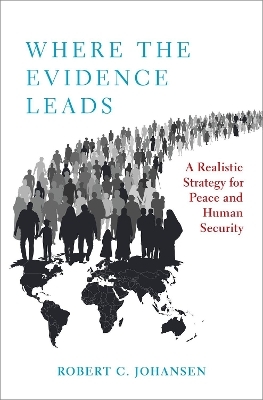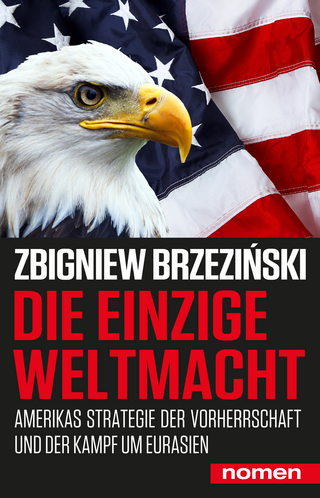
Where the Evidence Leads
Oxford University Press Inc (Verlag)
978-0-19-758665-5 (ISBN)
Why do war and political violence persist? Political realists argue that violent conflict and the struggle for power are inherent in the international system, and there is little we can do but manage it. However, as Robert Johansen argues in this path-breaking work, there are other ways forward. In Where the Evidence Leads, Johansen develops an "empirical realist" theory to enable the United Sates to respond more effectively to rising security threats. Together, peace research and security studies show that more security benefits are likely to result from maximizing the "causes" or correlates of peace than from maximizing military power. Ironically, a global grand strategy for human security, with national security folded into it, is likely to produce more security for the United States than a national security strategy. Peace reigns when states implement peace correlates, which range from addressing all nations' security fears to making life more predictable through better global governance. This approach, respectful of forgotten insights from Hans Morgenthau and others, revolutionizes thinking about national security policy by bringing it into a human security framework. The analysis shows that the anarchic, militarized balance-of-power system can be gradually changed with help from enhanced lawmaking, enforcement, and governance capacities. This thought-provoking book builds bridges between past policies-many of which have failed-and more deft ways of handling new realities that focus on building peace. In a world of threats, this book opens doors onto a future of sustainable peace, security, and hope.
Robert C. Johansen is Professor Emeritus of Political Science and Peace Studies at the University of Notre Dame in the Keough School of Global Affairs and Senior Fellow at the Kroc Institute for International Peace Studies.
Contents
Tables
Figures
Acknowledgments
Introduction: Are Peace and Security Really Possible?
Chapter 1: Understanding New Global Realities
1.1: War: Declining Utility
1.2: Non-State Actors: Rising Power
1.3: Non-Military Threats: Increasing Insecurity
1.4: National Military Competition: Growing Vulnerabilities
1.5: Nonviolent Campaigns: Offering Possibilities
1.6: The Rule of Law: Seeking Traction
1.7: Global Governance: Needing Nurture
Chapter 2: Conceiving a Security-Enhancing Theory
2.1: Respecting Empirical Reality
2.2: Respecting Human Dignity
2.3: Expanding Peacebuilding Theory
2.4: Recognizing Nationalism's Help and Hindrance
2.5: Cosmopolitanizing Nationalism
2.6: Open Questions
Chapter 3: Watching National Policies Fail
3.1: Misaligning Military Power and Security
3.2: Misaligning Economic Assets and Abolition of Poverty
3.3: Misaligning Economic Competition and Cooperation
3.4: Misaligning Environmental Assets and Environmental Needs
3.5: Misaligning the Power of Law and Global Security
Chapter 4: Recognizing Structural Breakdown
4.1: Bringing the Tragedy of the Commons
4.2: Forgetting the Reciprocity of Nuremburg
4.3: Missing Opportunities for a "New Era"
4.4: Ignoring Deficiencies of the Nation-State
4.5: Recognizing the Desirability and Impossibility of World Government
4.6: Considering a New System
4.7: Hanging onto Diplomatic Habits
4.8: Considering a Global Grand Strategy
Chapter 5: Developing a Security-Enhancing Strategy
5.1: Reducing Fears
5.2: Emphasizing Human Security
5.3: Respecting Reciprocity
5.4: Implementing Equity
5.5: Strengthening Legal Muscles
5.6: Growing Global Governance
5.7: Signs of Hope
Chapter 6: Fostering System Change
6.1: Transcending Hyper-Independence
6.2: Enlarging the Security Community
6.3: Delivering More than National Governments
6.4: Disciplining Sovereignty
6.5: Enlivening Peace
Chapter 7: Designing Life-Enhancing Architecture
7.1: Strengthening International Law
7.2: Expanding Global Monitoring
7.3: Establishing Multinational Police Enforcement
7.4: Beginning Global Legislative Conversations
7.5: Achieving Economic Well-being for the Poor
7.6: Improving Environmental Health
Chapter 8: Building Human Security
8.1: Bolstering U.S. Democracy
8.2: Cosmopolitanizing National Interests
Chapter 9: Where the Evidence Leads
9.1: Weighing National Security and Human Security
9.2: Universalizing Respect for Human Dignity
9.3: Finding Empowerment in Human Rights
9.4: Increasing Transnational Cooperation
9.5: Seeking Quality Peace
9.6: Exerting Influence for Human Security
9.7: "Working Toward a World Without War"
9.8: Realizing the Vision
Endnotes
Bibliography
Index
| Erscheinungsdatum | 01.11.2021 |
|---|---|
| Reihe/Serie | Studies in Strategic Peacebuilding |
| Verlagsort | New York |
| Sprache | englisch |
| Maße | 157 x 239 mm |
| Gewicht | 635 g |
| Themenwelt | Sozialwissenschaften ► Politik / Verwaltung ► Europäische / Internationale Politik |
| Sozialwissenschaften ► Politik / Verwaltung ► Staat / Verwaltung | |
| ISBN-10 | 0-19-758665-1 / 0197586651 |
| ISBN-13 | 978-0-19-758665-5 / 9780197586655 |
| Zustand | Neuware |
| Informationen gemäß Produktsicherheitsverordnung (GPSR) | |
| Haben Sie eine Frage zum Produkt? |
aus dem Bereich


